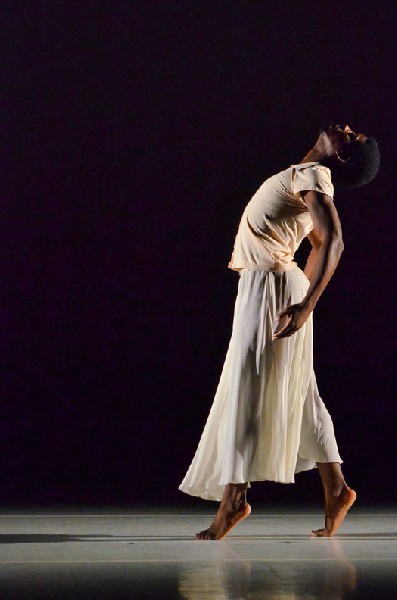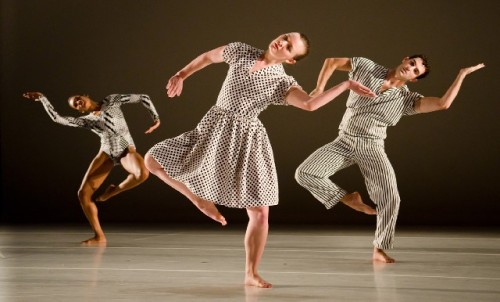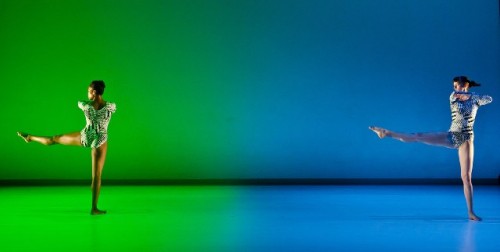Dance Heginbotham at Jacob’s Pillow
Mark Morris Veteran Formed Company a Year Ago
By: Charles Giuliano - Aug 11, 2012
Dance Heginbotham
Artistic Director, John Heginbotham
Managing Director, Adrienne Bryant
Stage Manager, Jenny Goelz
Jacob’s Pillow Dance
Doris Duke Theatre
August 8-12, 2012
Twin (2012)
Choreography, John Heginbotham
Music, Aphex Twin
Lighting Design, Nicole Pearce
Costume Design, Maile Okamura
Dancers, Michael J. Clark, Kristen Foote, Allysen Hooks, Lindsey Jones, BJ Randolph, Evan Teitelbaum
Closing Bell (2011)
Choreaography, John Heginbotham
Music, Tyondai Braxton
Lighting Design, Nicole Pearce
Costume Design, Maile Okamura
Dancers: Michael J, Clark, Allysen Hooks, BJ Randolph, Evan Teitelbaum
Last year, the newly formed company Dance Heginbotham, performed as a part of the free Jacob’s Pillow Dance program Inside Out.
This week the company has been invited back to the intimate Doris Duke theatre. Last night, there was a heady sense of anticipation. The capacity audience was there primarily as an endorsement of Pillow’s track record for presenting fresh works by emerging artists.
Based on the enthusiastic reception for an amazingly inventive, engaging, witty and technically flawless program Dance Heginbotham promises to be penciled in, whenever possible, for many returns to Pillow stages. We venture to guess that the company will grow to be much anticipated favorites with audiences.
Which speaks to the mandate of Pillow, and why it is one of the world’s renowned dance festivals. While the best known companies regularly appear in the larger Ted Shawn Theatre the artistic director, Ella Baff, is constantly on the prowl for top tier emerging artists and companies. The Inside Out stage is literally a launching platform to integrate these artists into the mainstream programming.
Not that chorographer John Heginbotham is a stranger to the Ted Shawn stage. He has performed at Pillow regularly as a 14-year-veteran of the Mark Morris company. While with Morris he started to focus increasingly on chorography.
A year ago he formed his company for which he choreographs but, with which, he does not perform. He prefers to step back to get a better perspective on what is occurring on stage. He joined the dancers on stage for curtain calls.
It is inevitable that Heginbotham would be influenced by Morris. But based on the two piece program- Twin and Closing Bell - while one might identify the signature of Morris’ playful inventiveness, in a very short time, the company has found its own very distinct style and identity.
This is particularly evident in Heginbotham’s selections of new experimental music combining instruments with digital/ electronic sounds. Morris more often draws on classical music. A confluence, however, is the manner in which Heginbotham, like Morris, is so finely attuned to what the music provides as resources for dance.
The music, by Aphex Twin, for Twin and by Tyondai Braxton for Closing Bell was unfamiliar to me and I am sure for the audience as well. Even on its own terms the music proved to be intriguing and represents a kind of next generation from the rhythmic, repetitive, minimalist styles of the masters Philip Glass and Steve Reich. We saw dance set to Reich just last week with the Royal Winnipeg Ballet.
Twin was more playful, lighter and more varied than the gravitas we find in the often humorless compositions of Glass and Reich. Heginbotham has taken full advantage of that lighter touch in movement that amazed but also made us smile and even laugh.
The dance was performed in a white cube space. That was made evident to us when, during intermission, the white material that covered the floor was pulled up revealing the usual black stage with lines. The whiteness was an important aspect of the lighting design by Nicole Pearce and the black and white, varied costumes by Maile Okamura.
It featured three women and two men. Two of the women, arguably the Twins, Kristen Foote and Lindsey Jones, were similarly attired in op art, black and white, patterned, long sleeved leotards. The third woman wore a polka dot patterened dress with full skirt. BJ Randolph wore a white t-shirt over a floor length, white, gauze skirt. Evan Teitelbaum was outfitted in what appeared like black and white striped pajamas. Michael J. Clark, who did not dance, but appeared now and then at the back of the stage near the exit, was attired in a black business suit. It was never clear just why he was there or his role in the narrative.
Not to say that Twin was a story telling dance. But it was indeed separated into interludes and moods that changed with shifts in the music. There were often comedic elements as the dancers struck cartoonish poses with arms set out at 90 degree angles that flipped up and down matching a similar akimbo stance with legs and feet. We sensed that it was OK to be amused.
Since we had the Twins, then the mismatched other three dancers, we focused on different individuals and pairings. Often it seemed that both through costume design, that gauzy skirt, and by intention Randolph was the odd man out. Indeed, there were times when he moved about the floor in what seemed to be agonized isolation. The other non twin pair also interfered, harassed, and impeded him. I’m not sure what it meant but it drew our attention with an ersatz story line.
The Twin thing became apparent when the two women, Clark and Jones, performed on a stage divided by areas of green and blue light. They stayed within their zones in synch but also making us aware of a deliberate distance and tension between them. It also brought to our attention the same choreography flowing through two very different bodies. In the case of Foote, a more compact and disciplined movement, and with Jones, all gangly, floppy about, and gonzo.
The Twins sat out the second half of the program; actually a few rows in front of us.
For Closing Bell the sturdy body of Hooks, in a dress, was combined with the three men in colorful, off the rack, combinations of shirts and pants. The dance started with a dappled, pointillist pattern of diffused, soft light across the stage.
The music did indeed have a heavy, clanging sound. The choreography seemed more concise with fewer variations than were seen in Twin. Again, Radolph appeared to be the featured leader. With arms straight at his side he hopped up and down. This hopping about infected the other dancers, one at a time, until they formed a tight, hopping circle around him. Then with a flash they fell to the floor in a circle flailing and moving about. As they progressed their sweaty bodies left a darker stain on the floor.
In another circled sequence, one by one, they seemingly pulled a gun and shot each other. As the victim collapsed to the floor the shooter, as an ersatz gunslinger, blew the smoke away from the end of the barrel then holstered the six shooter. It was a nicely surprising invention.
There were additional playful elements accented by props. Teitelbaum went off stage returning with a kid’s cap while Hooks sported a mask.
When it ended the audience applauded with enthusiastic delight. There were scattered standing Os. It was a vivid endorsement for a refreshingly inventive, emerging company.
Y’all come back ya’ heah.






